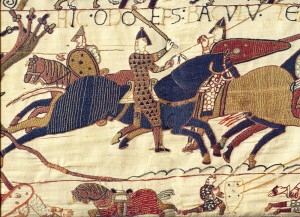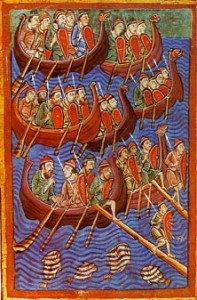Chapter 3. The Transatlantic Age
3.2 Beginnings of Globalism
In Chapter 2 we considered the very deep history of human occupation in the Americas. Here, we do the same for the Europeans.
Northwestern Europe to 1491
The earliest human-made or anthropogenic tools discovered in France have been dated to more than 1.5 million BPE, but that does not mean that there has been continuous human occupation of the region. The area’s multiple climate zones and various entry points made it a crossroads for human traffic over millennia. Neanderthal populations appear around 300,000 BPE but are thought to have gone extinct around 30,000 BPE. Modern humans (in this case, Cro-Magnons) became the dominant hominid species. They enjoyed a long run, but glaciation scoured humans and other fauna from much of northwestern Europe until about 15,000 years ago. It was only then — about the same time humans were appearing in the Americas, if not some years later — that humans returned to northern France and the British Isles.
The emergence of agricultural societies in the Neolithic, about 4,000-6,000 BPE, occurs at about the same time teosinte cultivation emerged in Mesoamerica. At about 2800 BCE, people in what is now France began working in bronze; evidence suggests that it was about 2150 BCE before Britons began to do the same. The so-called Iron Age, however, did not arrive for another 1,000 to 1,200 years.
The experience of the British Isles in the pre-contact period illustrates processes at work across Europe. What leaps out is the succession of cultures that arrived in Britain and established dominance. Indigenous British populations were subjected to repeated influxes of newcomers from the mainland of Europe, the most consequential waves beginning with the Romans about 2,000 years ago. British culture was strongly influenced by successive invasions, including the Germanic arrivals of the fifth century CE and repeated incursions and immigrations from Viking homelands from the eighth century through to the 10th century (one arm of which would carry on across the Atlantic). And while the British Isles would sustain many localized seagoing, fishing economies, the core economic activity was agriculture. This was true in France as well, and the number of hunter-gatherers in both territories was insignificant.

The indigenous Celtic cultures of northwestern Europe and the British Isles continued to be pushed to the margins in the late pre-contact period. In England and Wales that process accelerated with the arrival of the Normans (in large measure the descendants of Viking immigrants to France) in the 11th century. The society that emerged in England — and that was in place in 1492 — was thus a hybridized one dominated by an aristocracy of continental origin and a landscape of often fractious princelings/chieftains with a warrior class and clergy dominating a large agricultural peasantry. The “commoners” were themselves a mix, but in many districts in Britain throughout this period they were essentially ethnically different from their feudal masters. (Everyday artifacts of this relationship are the words used to describe meats: English peasants raised pigs, chickens, and cows, which were transmogrified in the market and on the banquet-hall table into pork (porc), poultry (poulet), and beef (boeuf), words derived from their conquerors’ native Norman French.)
While England’s boundaries were still undefined in this period and Wales resisted English domination, Scotland and Ireland were utterly distinct and their political units were mostly organized around chieftainships. What can be said of these northwestern European peoples in this period is that their political and economic conditions were very unsettled, that they had developed important technologies, and that their identities were necessarily fluid and somewhat tribal.[1]
The First Voyageurs: the Vikings and Others

In the eighth century, Norsemen, or Vikings, began settling parts of the Faroe, Shetland, and Orkney Islands in the North Atlantic. For nearly four centuries they went wherever treasure was, trading as far as Byzantium and Kiev in the east. In the west they raided Ireland and England, continuing south to the Italian peninsula. Their gun-and-run approach — sailing into a port, seizing its gold, and murdering or enslaving its people before fleeing — belies the fact that they were also settlers. They made homes throughout the British Isles, and they began settling Iceland in approximately 870 CE. One Viking, known to us as Erik the Red (ca. 950-1003), was accused of murder and banished from his native Iceland in about 980. Erik explored to the west and later founded a settlement on a poorly charted, snowy coastline. Knowing that this bleak land would need many people to prosper, Erik returned to Iceland after his exile had passed and coined the word “Greenland” as a branding ploy that he hoped would appeal to the overpopulated and treeless settlement. Erik sailed again to Greenland in 985 and established two colonies with a population of nearly 5,000.
Leif Erikson (ca. 970-1020), son of Erik the Red, and other members of his family began exploring the North American coast in 986 CE. Leif landed in three places, and in the third established a small settlement called Vinland. The location of Vinland is uncertain, but an archaeological site on the northern tip of Newfoundland at L’Anse aux Meadows has been identified as a good candidate. It was a modest Viking settlement and is the oldest confirmed presence of Europeans in North America. The settlement in Vinland was abandoned in struggles between the Vikings and the native inhabitants, who the newcomers called Skraelingar. Bickering also broke out among the Norsemen themselves, and the settlement lasted less than two years. The Vikings would make brief excursions to North America for the next 200 years, though further attempts at colonization were thwarted.
By the 13th century, Viking civilization was in retreat; Iceland and Greenland entered a period of decline during a little ice age. Christianity and the emergence of a unified Christian kingdom in Norway caused division within the Viking world. As well, Europe soon fell prey to a series of devastating epidemic diseases, and what knowledge scholars, sailors, and governments had of Viking explorations was lost or ignored. Apart from the traces left behind at L’Anse aux Meadows and the possibility that some genetic material might have found its way into the Aboriginal communities of the region, the Viking legacy evaporated with their departure. Vinland was a dead end.
Other apocryphal accounts of European encounters with the Americas exist. These include stories of St. Brendan’s voyages from Ireland, Prince Madoc’s expedition from Wales, and the possibility of fishing fleets sailing out of Bristol, England, all the way to Newfoundland. However, none of these stories can be substantiated by evidence; neither can the suggestion that African or Chinese voyages across open seas reached the Americas. There are also tales of classical-era Romans and Egyptians, and even Old Testament “lost tribes of Israel” crossing the Atlantic. Against these unconfirmed tales, there is some evidence to suggest that Inuit sea voyagers may have washed ashore in western Europe, but none of these encounters appears to have had any significant consequences to the Aboriginal North Americans or to the Europeans they may have encountered.
All of this is important to consider against the many efforts Europeans launched after 1492 to claim all or parts of the Americas. Often these claims were made on the strength of long-term connections that simply did not exist in any form other than myth. This is not to say that crossing the Atlantic from east to west was impossible before 1492, although prevailing winds and sea currents made it fiendishly difficult and dangerous. Boats sailing out of the north of Spain and the west coast of France and possibly Portugal as well pursued fish and whales into the North Atlantic and may have done so before Columbus. Indeed, the enthusiasm with which Basque, Bristol, and French whaling and fishing fleets patrolled the Grand Banks in the era of recorded voyages suggests that they were one step ahead of John Cabot’s voyage in 1497 at the very least. Ultimately, European claims were principally made against one another, rather than against Aboriginal occupants whose status as non-Europeans and non-Christians was critical to the very idea of imperial expansion.
Key Points
- Conditions in northwestern Europe were highly unsettled in the five centuries leading to contact.
- It was not uncommon for the ethnicity and language of a ruling class to be distinct from that of the subject peoples.
- Strong seagoing traditions among the Vikings led to transatlantic explorations with what appear to be few long-term ramifications.
Attributions
Figure 3.2
A detail from the Bayeux Tapestry showing Odo, half brother to William the Great, cheering his troops forward by LadyofHats is in the public domain.
Figure 3.3
Danes about to invade England by Rdnk is in the public domain.
- For a survey of the repeated and overlapping population tides that washed across Britain, see David Miles, The Tribes of Britain (London: Weidenfeld & Nicolson, 2005). ↵

